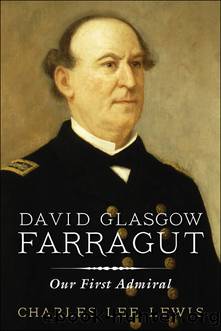David Glasgow Farragut by Charles Lee Lewis

Author:Charles Lee Lewis [Lewis, Charles]
Language: eng
Format: epub
ISBN: 9781612512990
Publisher: Naval Institute Press
XXII
FORCING THE ENTRANCE TO MOBILE BAY
1
IT RAINED hard near sundown on August 4, but by midnight it was clear and hot, with a very light breeze just rippling the surface of the water. Farragut, after so many weeks of anxious watching and waiting, was not well and slept restlessly. About three oâclock he called his faithful Negro steward, John H. Brooks, and sent him to investigate the weather. The Admiral was greatly pleased when he soon returned with the report that, though it was cloudy, the wind was southwest. This was just what he wanted, as it would blow the smoke of battle directly into the eyes of the gunners in Fort Morgan. Friday, the sailorâs unlucky day, was bringing good weather; it was an omen of victory. So Farragut said quietly to Brooks, âWe will go in, this morning.â1 At about this time, some one on watch on the deck of the Manhattan saw a comet flash across the heavens towards the northeast. Another omen of victory.2
Soon throughout the fleet were heard the boatswainsâ shrill pipes and the calls, âAll hands!â and âUp all hammocks!â Last preparations for battle, and an early breakfast were quickly finished, as the vessels took their places according to plan, in the following order: Brooklyn with the Octorara lashed to her port side, Hartford paired off similarly with the Metacomet, Richmond and Port Royal, Lackawanna and Seminole, Monongahela and Kennebec, Ossipee and Itasca, and Oneida with the Galena. The vessels lashed to the three leading ships were sidewheelers, which were less likely to be fouled by obstructions and somewhat less likely to strike submerged torpedoes, or mines.3 To the starboard, the monitors formed column with the Tecumseh leading and followed by the Manhattan, Winnebago, and Chickasaw. Four small gunboats were stationed to the southeast of Fort Morgan; while six other light gunboats invested Fort Powell and blocked Grantâs Pass.4
Forming column took time and was not completed until about five-thirty. Farragut was then just finishing a cup of coffee with Captain Drayton and Fleet-Surgeon Palmer, and remarked casually, âWell, Drayton, we might as well get under way.â5
Farragut had agreed to allow Alden in the Brooklyn to lead the line âonly at the urgent request of the captains and commanding officers.â6 She was the only vessel with four chase guns and âan ingenious arrangement for picking up torpedoes,â affixed to the jib boom. Farragut thought that âexposure is one of the penalties of rank in the navyâ6 and, as the battle developed, he greatly regretted he had yielded to the wishes of his officers. In 1856 Alden had assisted Superintendent A. D. Bache in the preparation of the chart of Mobile Bay.7 Farragut did not refer to this, and it probably had nothing to do with his permitting Alden to take the lead.
By six oâclock the fleet was moving on a northerly course toward the entrance to the bay. Forty minutes later it was daylight, and flags were hoisted from peak, staff, and every masthead. Farragutâs blue pennant gracefully floated from the Hartfordâs mizzen.
Download
This site does not store any files on its server. We only index and link to content provided by other sites. Please contact the content providers to delete copyright contents if any and email us, we'll remove relevant links or contents immediately.
| United States | Abolition |
| Campaigns & Battlefields | Confederacy |
| Naval Operations | Regimental Histories |
| Women |
In Cold Blood by Truman Capote(2702)
Steve Jobs by Walter Isaacson(2459)
All the President's Men by Carl Bernstein & Bob Woodward(1971)
Lonely Planet New York City by Lonely Planet(1857)
The Murder of Marilyn Monroe by Jay Margolis(1751)
The Room Where It Happened by John Bolton;(1729)
The Poisoner's Handbook by Deborah Blum(1671)
And the Band Played On by Randy Shilts(1632)
Lincoln by David Herbert Donald(1622)
The Innovators by Walter Isaacson(1612)
A Colony in a Nation by Chris Hayes(1530)
The Innovators: How a Group of Hackers, Geniuses, and Geeks Created the Digital Revolution by Walter Isaacson(1519)
Under the Banner of Heaven: A Story of Violent Faith by Jon Krakauer(1425)
The Unsettlers by Mark Sundeen(1347)
Amelia Earhart by Doris L. Rich(1345)
Birdmen by Lawrence Goldstone(1345)
Decision Points by George W. Bush(1261)
Dirt by Bill Buford(1247)
Zeitoun by Dave Eggers(1231)
